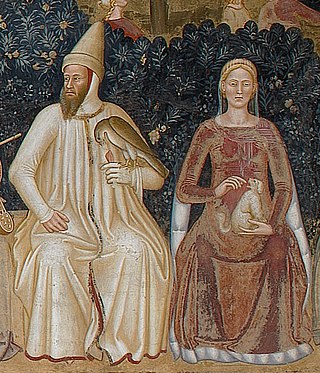The Capetian dynasty, also known as the "House of France", is a dynasty of European origin, and a branch of the Robertians. It is among the largest and oldest royal houses in Europe and the world, and consists of Hugh Capet, the founder of the dynasty, and his male-line descendants, who ruled in France without interruption from 987 to 1792, and again from 1814 to 1848. The senior line ruled in France as the House of Capet from the election of Hugh Capet in 987 until the death of Charles IV in 1328. That line was succeeded by cadet branches, the Houses of Valois and then Bourbon, which ruled without interruption until the French Revolution abolished the monarchy in 1792. The Bourbons were restored in 1814 in the aftermath of Napoleon's defeat, but had to vacate the throne again in 1830 in favor of the last Capetian monarch of France, Louis Philippe I, who belonged to the House of Orléans. Cadet branches of the Capetian House of Bourbon are still reigning over Spain and Luxembourg.
The 1330s was a decade of the Julian Calendar which began on January 1, 1330, and ended on December 31, 1339.

The Duchy of Athens was one of the Crusader states set up in Greece after the conquest of the Byzantine Empire during the Fourth Crusade as part of the process known as Frankokratia, encompassing the regions of Attica and Boeotia, and surviving until its conquest by the Ottoman Empire in the 15th century.

Rudolf I of Bavaria, called "the Stammerer", a member of the Wittelsbach dynasty, was Duke of Upper Bavaria and Count Palatine of the Rhine from 1294 until 1317.

Duke of Calabria was the traditional title of the heir apparent of the Kingdom of Naples after the accession of Robert of Naples. It was also adopted by the heads of certain Houses that had once claimed the Kingdom of Naples in lieu of the royal title.

The Capetian House of Anjou, or House of Anjou-Sicily, was a royal house and cadet branch of the direct French House of Capet, part of the Capetian dynasty. It is one of three separate royal houses referred to as Angevin, meaning "from Anjou" in France. Founded by Charles I of Anjou, the youngest son of Louis VIII of France, the Capetian king first ruled the Kingdom of Sicily during the 13th century. The War of the Sicilian Vespers later forced him out of the island of Sicily, which left him with the southern half of the Italian Peninsula, the Kingdom of Naples. The house and its various branches would go on to influence much of the history of Southern and Central Europe during the Middle Ages until it became extinct in 1435.
Przemko II of Głogów was a Duke of Żagań, Ścinawa, etc., from 1309 to 1321, Duke of Oleśnica, Namysłów, Gniezno and Kalisz from 1309 to 1312 and Duke of Głogów starting in 1318.

Beatrice Regina della Scala was Lady of Milan by marriage to Bernabò Visconti, Lord of Milan, and politically active as the adviser of her spouse.
The Seneschal of Gascony was an officer carrying out and managing the domestic affairs of the lord of the Duchy of Gascony. During the course of the twelfth century, the seneschalship, also became an office of military command. After 1360, the officer was the Seneschal of Aquitaine. There was an office above the seneschalcy, the Lieutenancy of the Duchy of Aquitaine, but it was filled only intermittently.
A princely rebellion or princely revolt is an intrastate armed conflict by a prince against a reigning monarch of his own family, the ruling dynasty. A prince may rebel against a well-established monarch in order to seize the throne for himself immediately, to ensure his supposed right to sit on the throne in the future, or to secure other rights, privileges or interests such as appanages, alliances or sources of revenue that the monarch allegedly encroached upon, or failed to deliver or guarantee.